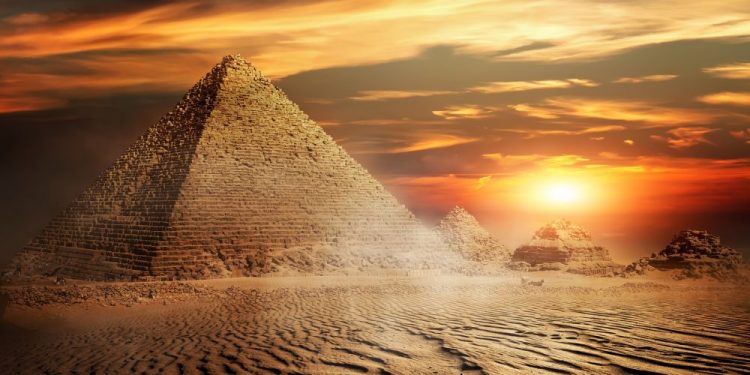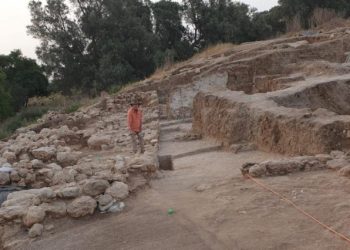- The Pyramid of Ahmose marked the end of the Egyptian Pyramid Building era
- It was the last pyramid of Egypt, built more than 1,200 years after the Step Pyramid
- The pyramid was not intended as a tomb
Around 2,700 BC Ancient Egyptian construction evolved. Right until then, royalty and the Pharaohs were buried inside intricately built mastabas; a flat-roofed, rectangular structure with inward sloping sides, constructed out of mud-bricks (from the Nile River).
Then came along Imhotep, the Royal Vizier of Pharaoh Djoser and decided to change the way Mastabas were built. Djoser’s Pyramid is believed to have undergone a number of revisions and redevelopments that saw the pyramid look entirely different from its original plan.
The Pyramid of Djoser is considered one of the very first large-scale cut stone construction’s. Djoser’s “evolved mastaba” kick-started the process of pyramid building in Egypt, laying down the foundations for the construction of what would eventually become the greatest structure built in the history of ancient Egypt; the Great Pyramid of Giza, allegedly built as the eternal resting place for Pharaoh Khufu.
But a process that starts also finishes. And so did the ancient Egyptian process of Pyramid building come to an end, around 1525 BC with the end of the reign of Ahmose I.
During the Eighteenth Dynasty of Egypt, the dynasty of the New Kingdom of Egypt, the country achieved the peak of its power.
Spanning from around 550 to 1292 BC, this dynasty is colloquially referred to as the Thutmosid Dynasty due to the four pharaohs named Thutmose that reigned over Egypt.
The Eighteenth Dynasty of Egypt also saw other famous Pharaohs rule over the land, including Tutankhamun, whose tomb was discovered by British archaeologist Howard Carter in 1922. The Eighteenth Dynasty of ancient Egypt also saw other important and famous Pharaohs rule the country; it was during this era that Akhenaten, the Heretic Pharaoh ruled over Egypt with his wife, Queen Nefertiti.

Furthermore, the dynasty is notorious and unique among all other Egyptian dynasties since it saw two women rule as sole pharaoh; Hatshepsut considered one of the most innovative rulers of ancient Egypt, and Neferneferuaten, usually identified as the iconic, and beautiful Nefertiti. Together with her husband, Nefertiti ruled over Egypt in a time of religious revolution, and arguably the wealthiest period of ancient Egyptian History.
It was a Dynasty of change, of innovation and revolution.
In addition to its famous rulers such as Tutankhamun, Hatshepsut, Akhenaten and Nefertiti, this dynasty is marked by one important thing: The end of Pyramids in ancient Egypt.
It was during the eighteenth Dynasty that the ancient Egyptians decided to no longer build pyramids, and it was precisely then when the last ancient Egyptian pyramid was built; the Pyramid od Ahmose I.
Founder of the eighteenth dynasty of ancient Egypt and member of the Theban Royal House, Ahmose’s reign laid the foundations for the New Kingdom, under which ancient Egypt reached its peak.
Ahmose was also the last pharaoh in the history of Egypt to build a pyramid.
The Last Ancient Egyptian Pyramid
In 1899, an archaeological mission discovered the ruins of Ahmose’s Pyramid in Abydos. Although experts did not immediately know to whom the structure belonged, a few years later in 1902 evidence surfaced that the pyramid belonged to Ahmose I. The pyramid was roughly built around 1,500 BC, some 200 years after the Egyptians had officially stopped building pyramids.
The pyramid, ruined and collapsed has most of its outer casing tones missing. They were most likely used in other building projects after his region and over the years. Despite this, archeologist Arthur Mace discovers two beautifully preserved rows of casing stones, estimating the structure’s steep slope of around 60 degrees.
In comparison, the Great Pyramid of Giza had a less pronounced 51-degree slope. The pyramid complex of Ahmose I was vast. Archaeological excavations revealed two temples erected by Ahmose-Nefertari, Ahmose’s queen. A third temple exists at the site and it is similar to the pyramid temple in terms of form and scale.
Experts argue that the axis of the pyramid complex is associated with a number of ancient monuments that were placed out along a kilometer of the desert. Several structures exist along this direction including a large pyramid dedicated to Ahmose’s grandmother, a rock-cut underground complex believed to have served as either a royal tomb or representation of the Osirian underworld and a terraced temple that was constructed against the high cliffs, built with massive stone and brick terraces.
Tomb or no tomb?
The purpose of the pyramid remains unclear, just as the debated purpose of all other ancient Egyptian pyramids, starting from the first Egyptian Pyramid, the Step Pyramid of Djoser.
It is disputed in the Egyptological community whether or not the pyramid was Ahmose’s eternal resting place, or whether there is a possibility it was a cenotaph– an empty tomb or a monument erected in honor of a person.
Initial explorations of the pyramid revealed no traces of internal chambers, and it is agreed that it is very unlikely that a burial chamber could be located in the midst of the pyramid’s rubble core.
The pyramid did not survive the harsh conditions it was exposed to in the desert and poor construction work with materials unworthy of a pyramid.
Following the mysterious similarities to other ancient Egyptian pyramids, the mummy of Ahmose I was discovered in 1881 within Deir el-Bahri “the Monastery of the Sea,” a complex of mortuary temples and tombs located on the west bank of the Nile, part of the Theban Necropolis.
This means that just as the first pyramid ever built in Egypt, around 2,600 BC lacked the Pharaoh’s mummy, the last pyramid ever built in ancient Egypt also lacked a mummy. Despite these facts, it still continues to be claimed that the ancient Egyptians were tombs of the Pharaohs, built to safeguard their journey in the afterlife.
For more than 1,200 years the ancient Egyptians constructed Pyramids. Some of them were a success like the Pyramid of Khufu, Khafre, Menkaure, as well as the Step Pyramid, the Bent Pyramid and the Red Pyramid (the third largest in Egypt). But these are just some of the many pyramids that have been built throughout the years, starting in the Third Dynasty of Ancient Egypt, circa 2686 – 2613 BC, and concluding with Ahmose’s pyramid during the 18th Dynasty, circa 1550 – 1292 BC.
Curiously, the last three ancient Egyptian pyramids, Neferhotep I, Sobekhotep IV, and Ahmose I were built at Abydos. It is noteworthy to mention that the pyramids of Neferhotep I and Sobekhotep IV are said to be most likely a pyramid, similar in design to the pyramid of Khendjer, but also possibly a mastaba.
After all, pyramids in Egypt are thought to have evolved from mastabas. After Ahmose’s I reign the pyramid was abandoned, and the rock-cut shaft tombs in the Valley of the Kings would be where the Pharaohs and royalty were buried, leaving no need for Pyramids any longer.
Therefore, it can be said with confidence that Ahmose’s I pyramid was the last royal Egyptian pyramid ever constructed, bringing to an end a chapter in history that saw mankind built some of the largest, most impressive structures in Egypt.











